If you’re new to indoor cactus plants, you might be wondering just how much light they really need.
After all, these are desert plants and used to baking all day in the scorching sun, right?
How long can a cactus live without sunlight?
Actually, most indoor cactus plants will do well with around four hours of bright sunlight, and can do quite well with only artificial light sources.
Of course, different types of cacti have different needs, and those needs can change throughout the growing cycle. Check out the complete breakdown of cactus light requirements.
How much light does a cactus really need?
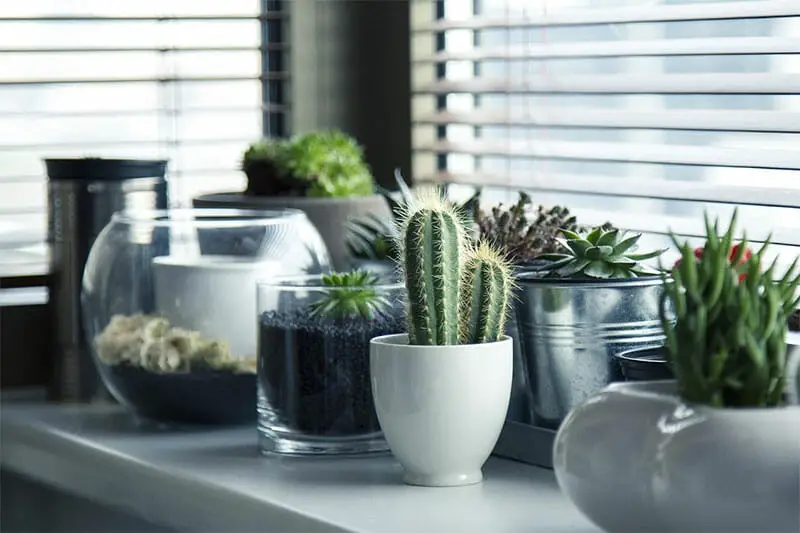
The short answer is probably less than you think. Spiny cacti developed their distinct shapes to minimize the amount of sunlight they get.
This is one of the reasons for their spines, which are actually highly modified leaves. If they were covered in leaves, they’d get even more desert sunlight, which would cause them to lose too much of their precious water.
Indoor spiny cacti should generally get about four hours of bright, indirect sunlight. This means that they should be situated in a room or near a window that is brightly lit by natural light for at least four hours each day.
A good way to test the brightness of the light is by holding your hand over a sheet of plain white paper in the spot where you plan to keep your cactus. If you see a crisp shadow, the light is bright enough.
When there is too much sunlight
The closer your cactus is to full, bright sunlight, the more likely it is to get sunburned. If you put it directly on a window ledge where it will receive direct sunlight most of the day, you might start to notice the plant taking on a bleached or brown appearance.
This is the effect of too much light and heat. If you notice quickly, it probably won’t be fatal, but it can stunt your cactus’ growth or cause it to grow in unusual ways.
Bright, diffuse light won’t risk sunburning your plant, so if you know your window will get direct sun, try putting your cactus on a table beside or below the window, or on a wall opposite, rather than directly on the sill.
If you don’t have a window that will provide adequate light, artificial lights will work as well, but because these provide less energy than sunlight, your plants will require more hours of light. Cactus plants will even do well in rooms lit by fluorescent light, but may need up to 16 hours of light each day in order to stay healthy.
Of course, different types of cacti have different light needs, and you should always check on the preferences for the specific variety you plan to get.
Or, better yet, choose your location first, and pick a variety of cactus that you know will thrive there. Here are a few to consider.
Full Sun Cacti
Opuntia (Prickly Pear)

There are lots of varieties of prickly pear cactus, and they’re found growing wild in all kinds of environments—even southern Canada!
Though they’ll grow quite large if planted outdoors, the smaller varieties also do well as indoor cacti.
They do like a lot of light, though, so don’t be afraid to let them get a little extra sun. During summer months, you may even want to take their pots outdoors so they can enjoy even more light.
Cereus, or Night Blooming Cactus
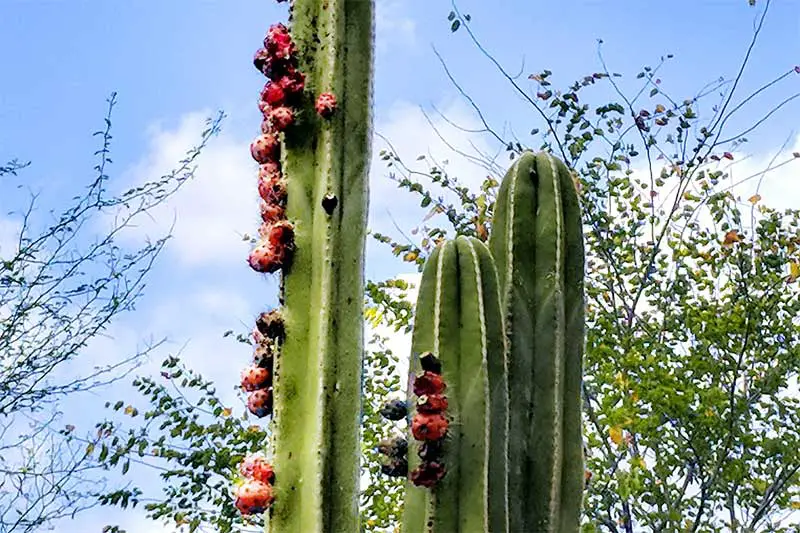
This is a great plant for beginners.
Like prickly pear, they’ll grow outdoors, but do just fine in pots as long as they get enough light.
They require slightly more water and richer soil than other types of cactus, so consider blending a small amount of regular potting soil into cactus soil before planting.
Their pale-colored blooms are nocturnal, and highly fragrant.
Echinocereus, or Hedgehog Cactus
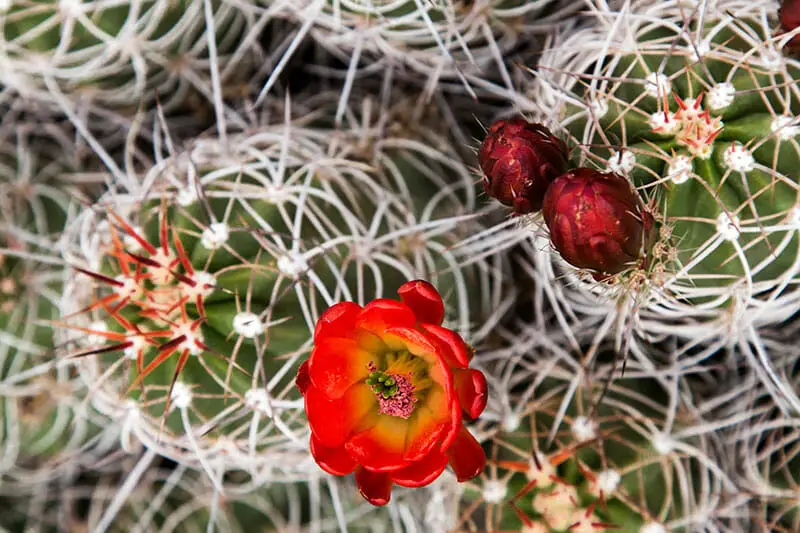
Native to the American Southwest, the hedgehog cactus forms low-growing clusters that really do look like colonies of rolled-up hedgehogs all piled together.
When grown in pots, the clusters may occasionally need to be broken up and repotted to leave adequate room for growth, though like most cactus varieties, they are relatively slow growing.
They have colorful flowers, and many varieties even produce edible fruits. They prefer lots of sun, but will tolerate bright, indirect light.
Ferocactus, or Barrel Cactus
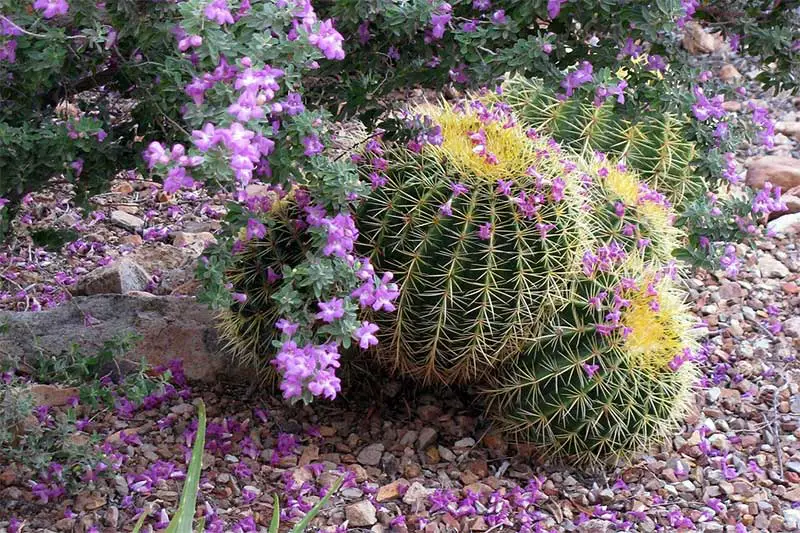
These are true desert cacti, found in the deserts of southern North America from the United States through central Mexico.
They grow in gravelly areas and prefer lots of sun and warm temperatures.
There are lots of varieties of barrel cactus, though all of them are similarly barrel-shaped with profuse spines. They produce colorful flowers, though not as profusely as some species of cactus.
Shade Tolerant Cacti
Mistletoe Cactus

These strange looking plants are probably not what you first picture when you hear the word “cactus.”
Not only do their trailing stems bear little resemblance to the traditional cactus shape, but in the wild, they’re considered epiphytes or “air plants,” meaning they grow on other plants rather than in soil.
They’re not parasites, but are rather like orchids, prefering to grow in the middle levels of a tropical rainforest, away from both the soggy forest floor and the blazing sun of the upper canopy.
They’re perfect for hanging baskets, and prefer no direct sun and only diffuse light.
Schlumbergera, or Christmas Cactus

Schlumbergera varieties are probably among the best known indoor cactus varieties. They include the “holiday” cactus plants known as Thanksgiving, Christmas, and Easter cactus, so called because of the time of year when they tend to bloom, though the names are often interchanged and can include different varieties depending on where the cactus plants are sold.
Like mistletoe cactus, schlumbergera are epiphytes and can’t withstand full sun. They prefer what’s known as “bright shade,” which means bright but diffuse light sources.
Scarlet Ball Cactus
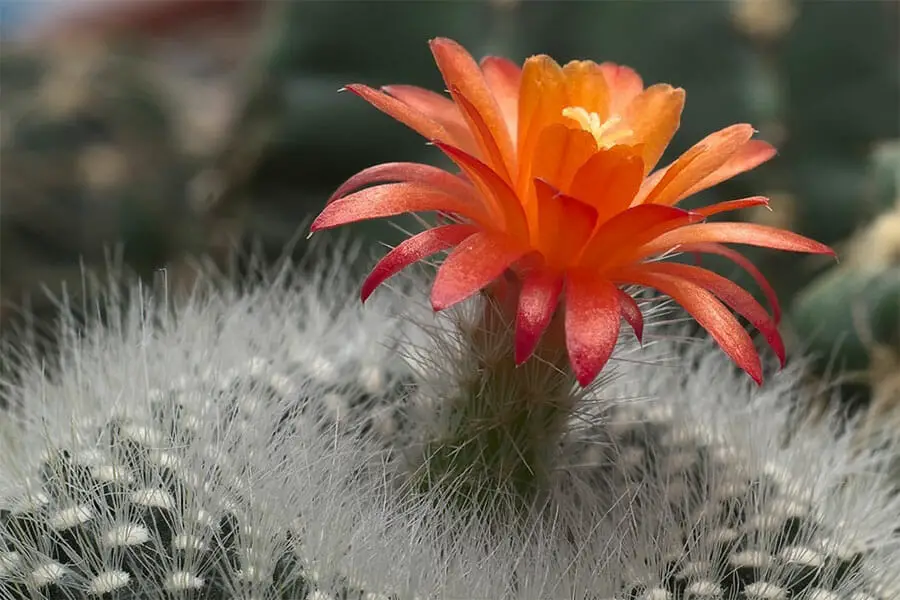
These showy little cacti are more traditional in their appearance—small, compact spheres covered in hairy spines.
Their name comes from the beautiful scarlet blossoms that spring from the crown of the cactus when it blooms.
Though these cacti can handle direct sun in the early morning and late afternoon, they don’t tolerate midday sun and heat well, and will do just fine with only bright indirect light.
Rebutia, or Crown Cactus

Perfect as a first cactus, the crown cactus is pretty, petite, and easy to grow.
They prefer partial shade or bright, diffuse light, but can’t tolerate the high temperatures associated with direct sun.
Their name comes from a crown of bright flowers that grow in shades of red, yellow, pink, or white.
Dormancy, how does it affect light requirements
Like many plants, cacti go through a dormant phase during which their metabolisms slow and they all but stop growing.
Typically, this occurs during winter, when temperatures fall and the amount of sunlight is reduced.
Dormancy occurs because these conditions aren’t optimal for the chemical reactions they need to photosynthesize and grow. However, it’s also an important part of the plant’s life cycle.
While you could artificially continue to provide light and warmth to “trick” the plants into thinking it’s still summer, many cacti require this dormant period in order to produce flowers, fruits, or seeds.
How does light affect cactus flowering?
For plants, timing is everything. Bloom too early, and the pollinators you rely on may not have arrived yet. Too late, and they’ve already moved on.
So plants, including cacti, developed their own inner clocks to let them know when it’s the right time to bloom.
This is directly tied to the ratio of light and dark time they get each day.
Plants that bloom in the fall or early winter (like Christmas cactus) can be encouraged to bloom or even forced to bloom out of season by covering them with an opaque cloth for 16 hour “nights” followed by eight hour days.
Other plants cycle through the dormant phase and will bloom only once they begin to grow once more.
If you’re struggling to get your cactus to bloom, check to see if the light you’re providing is making the plant think it’s the wrong time of year for flowering.
Requirements will differ from type to type, so be sure to research your particular cactus variety.
Providing light for indoor cacti
Now that you know how much light your cactus plants need, what’s the best way to provide it? You have several options:
Natural Light
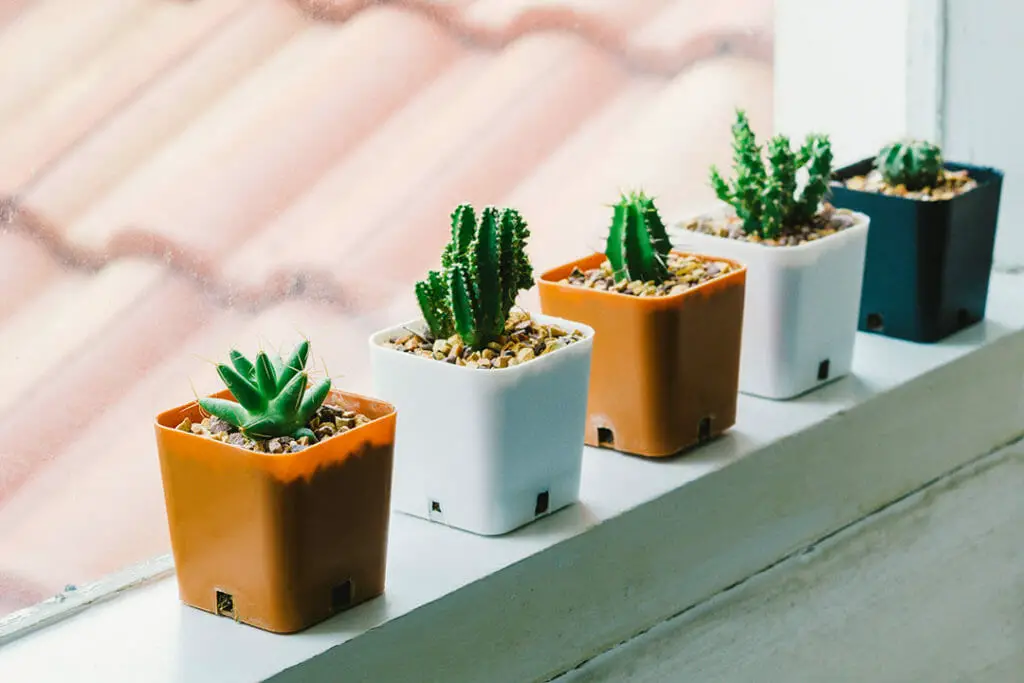
Whenever possible, opt for natural light for your plants. It provides the full spectrum of wavelengths that plants need to most efficiently photosynthesize and grow—plus it’s free!
For plants that prefer full (or direct) sunlight, look for a location that will allow them to catch four hours of light during their regular growing season.
Less is okay while the plants are dormant. If you live in northern areas, avoid sitting the plants too close to windows, where temperatures can dip below the rest of the room during the winter and place excess stress on the plant.
Similarly, plants that favor diffuse light can be sunburned by sitting too close to a window.
These do well in bright rooms away from direct sun, or in rooms where the windows have frosted glass or another means of diffusing the light.
If you’re not sure how bright the light really is, use the shadow test. Holding your hand over a sheet of white paper will produce a clear, crisp shadow in direct sunlight, but a softer, fuzzier outline in indirect light.
If you don’t see a shadow at all, chances are your light is too dim, and you’ll need to supply a little extra artificially.
Artificial Light
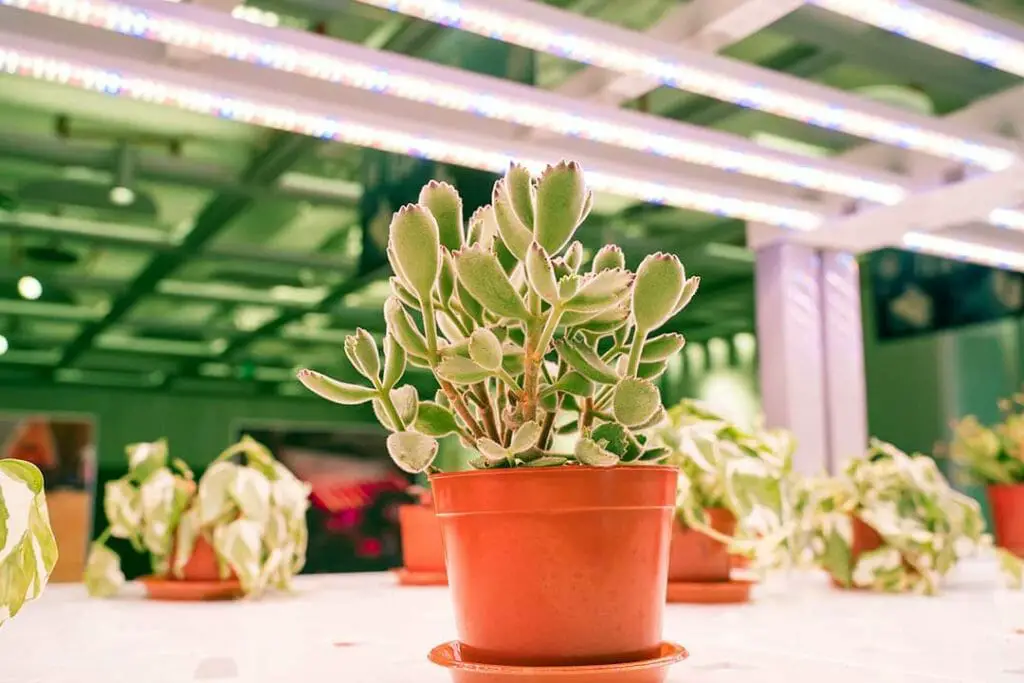
Artificial lights are not as high-energy as sunlight, so it takes more hours of artificial light to meet your plants’ needs.
However, you also don’t have to worry that you’re accidentally going to overheat or sunburn your plants when you’re using artificial lights, and these are a great alternative for spaces that don’t have easy access to windows, like an office cubicle or interior room.

We recommend this affordable indoor grow light that will work well for any cacti, if youdon’t have a lot of sun exposure in your indoor space.
- Full Sunlight Spectrum
- Integrated timer so you can set it up to make your cacti flower
- Adjustable brightness
LEDs have been a real game changer in the realm of plant-friendly lights. Previously, they required pricey fluorescent tubes designed to emit higher-energy or “full spectrum” wavelengths.
Now, LED lamps with a whole range of features are readily available, including some that clip directly to your desk or table, and others that include a dimmer feature that allows you to adjust for the needs of different plants without moving either lamp or plant (like the one we recommend above.
Many of these lamps use a mixture of red and blue LED lights.
These are the primary areas in which plants absorb light for use in metabolic processes. Blue lights emit a higher energy wavelength, and encourage photosynthesis and general growth.
Red lights, though lower energy, can help cue a plant as to seasonality, and are important for encouraging germination, root development, and flowering.
This does mean, however, that many of today’s lamps give off a rather strange purple light.
If you find this unslightly, you can opt for “sun-like” bulbs instead, but be aware that these tend to give off more heat, so you may need to do some testing to see how hot your lamp might run before setting it too close to your plants.
Conslusion
Though cactus plants might be desert dwellers by nature, this doesn’t mean they all need high temperatures and direct sunlight.
Most cactus plants will do best with bright, diffuse sun for only a few hours a day, but can get by with even less if you provide light from other sources.
Do you have favorite shade-loving or sun-loving cactus varieties? What about tips for choosing just the right location for an indoor cactus? We want to hear from you! Join in on the comments below.
Conclusion is misspelled. You have it spelled Conslusion.
What a wonder of a plant. a miracle cure with its Alovera. . l bought a lovely indor cactus it feel on its head completly distroyed it. do l still have a ruth? should l keep it ? l thankyou for your super display and hope to hear from you soon. dominique Collin-Fox. XXXXX
Put my Christmas cactus under table with a tablecloth so it has gotten no light for a week and the water should I be watering it at a regular time and giving it some sunlight
I need help. I’m new to these plants. I bought 20 of these plants. I put some outside in indirect sunlight and they seem to be doing ok. I put some inside in front of sliding glass doors they seemed to be be doing ok. All of the plants are either cuttings or very young plants. I’ve invested a lot of money in this hobby. I worried some were not getting enough sunlight so I bought a lamp. After 4 hours on yellow or Amber light some of the plants leaves had developed a reddish brown color on the tips. I turned the lamp off. Some of plants are supposed to turn colors. I have the watering down pat.. I spent as much as 30.00 on a black succlent. Please help.